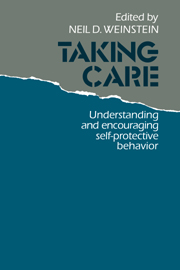15 - Cross-hazard consistencies: conclusions about self-protective behavior
Published online by Cambridge University Press: 03 February 2010
Summary
Introduction
A number of general conclusions about self-protective behavior can be distilled from the concepts, programs, and empirical findings described in the preceding chapters. The conclusions do not amount to a complete theory of risk behavior. As Cleary suggests in Chapter 6, no manageable theory could incorporate all the specific features that give different hazards and settings their uniqueness. Nevertheless, there are many cross-hazard consistencies, enough to provide a realistic starting point for the design of prevention programs and for the development of more detailed theories to fit particular situations.
The view of individuals as decision makers striving to weigh the potential costs of taking a precaution against the benefits that may be received is the basis for the most widespread model of self-protective behavior. This perspective is recognized, explicitly or implicitly, in every chapter in this volume (see, especially, Slovic, Fischhoff, & Lichtenstein, Chapter 1). The individual's beliefs about the likelihood and the severity of harm, the efficacy of a precaution, and the cost of acting are the central variables in such risk–benefit decision making. Evidence from investigations of health behavior, crime prevention, and natural hazards preparedness demonstrates clearly that these variables do make a difference.
How, then, do we explain people's failures to adopt precautions that could reduce their risk? Why do so few individuals use automobile seat belts, purchase flood insurance, or adopt low-fat diets? There are four major types of answers to such questions.
- Type
- Chapter
- Information
- Taking CareUnderstanding and Encouraging Self-Protective Behavior, pp. 325 - 336Publisher: Cambridge University PressPrint publication year: 1987
- 6
- Cited by

